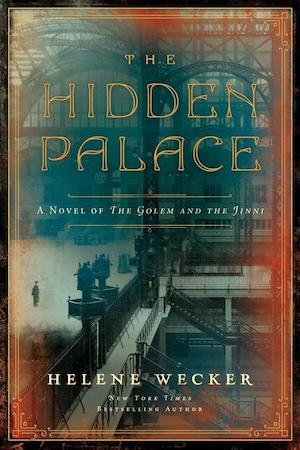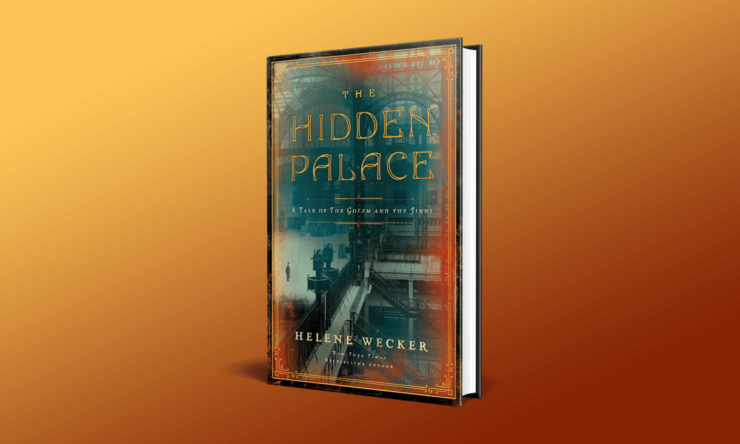The Hidden Palace is Helene Wecker’s long-awaited second novel. Wecker’s debut, The Golem and the Jinni, was published to no small acclaim in 2013. Those of us who remember that novel and its fantastic blending of myths from different traditions in the grounded setting of immigrant communities in late 19th-century New York have been anticipating The Hidden Palace for quite some time.
It lives up to its predecessor.
The Hidden Palace spans fifteen years, between 1900 and 1915. It continues to follow the golem Chava Levy and the jinni Ahmad through their lives in, respectively, the Jewish and Syrian immigrant communities in New York. But it also follows Sophia Winston, the young Park Avenue heiress whose brief encounter with Ahmad left her with an affliction that leaves her cold and shivering even in high summer; and the family—the daughter—of Rabbi Altschul. Rabbi Altschul inherits the books of Rabbi Meyer, who had helped Chava, and eventually comes to construct a golem of his own. A golem inherited by his young daughter Kreindel when she’s abruptly orphaned.
With only the very grudging support of her family, Sophia sets out to travel the Middle East in search of a cure. At least she’ll be somewhat warmer in the meantime. Sent to the uptown orphanage, Kreindel finds the golem—Yossele, she calls him—to be her one comfort. And in the Middle East, a female jinni—a jinneyeh—is banished from her people because iron does not harm her.
Buy the Book


The Hidden Palace
And Chava and Ahmad grow together, and apart. Chava is steady, dependable, compassionate. Ahmad is passionate, artistic, solitary, often heedless and selfish—and isolated, a person who can expect to never again hear his native language, who is neither fish nor flesh nor fowl. Their isolation, the things they share, draws Chava and Ahmad together: their differences push them apart. Chava reinvents herself as a teacher when her lack of ageing begins to draw suspicion. Ahmad shuts himself away from the world, working on a great piece of art, after his one friend dies. They spend years not speaking to each other. Is what links them greater than what divides them?
In the Middle East, Sophia, cut off by her family, encounters the banished jinneyeh. This jinneyeh has heard a legend of Ahmad. Angry and lonely, she demands that Sophia should take her to where Ahmad is. This, along with Chava’s discovery of Yossele in the basement of the orphanage where she’s employed to teach domestic science, leads to a climactic series of confrontations and realisations in the streets of early 20th-century New York.
Wecker treats early 20th-century New York with a deft specificity, focusing on immigrant—though here, to a greater degree, Jewish—communities. The setting, the society, leaps off the page, and though I’m not enough of a historian of the American 20th century to have any idea whether or not it’s accurate, it feels right, in that complex, nuanced way that depictions cities full of communities side-by-side often do. Throughout The Hidden Palace, like its predecessor, Wecker remains concerned not just with immigration and immigrant communities, but with assimilation in various forms, with the politics of community, with difference—with art, and change, and responsibility. Wecker’s characters have grown in complexity. Their concerns are more inextricably intertwined with responsibility, with growth and change, than before. But they are no less fascinating.
Wecker’s work, I think, bears comparison with Michael Chabon (or at least Chabon’s more New York, and more fantastical, works). Though that could just be because my major comparandum for a novel with an early-20th-century setting in and around Jewish immigrant communities in New York is The Amazing Adventures of Kavalier and Clay, with which it shares some concerns. And some approaches: The Hidden Palace is a deeply character-focused novel (one in which the city is itself another character), and one which is concerned with the domestic, the intimate, the quotidian. Even a golem and a jinni can have quotidian concerns as well as epic ones.
Eloquently written, deftly composed, The Hidden Palace is a gorgeous book. Measured, striking, both thoughtful and thought-provoking, it was well worth waiting eight years for. Though, selfishly, I do hope Wecker’s next work comes after a shorter wait!
The Hidden Palace is available from HarperCollins.
Liz Bourke is a cranky queer person who reads books. She holds a Ph.D in Classics from Trinity College, Dublin. Her first book, Sleeping With Monsters, a collection of reviews and criticism, was published in 2017 by Aqueduct Press. It was a finalist for the 2018 Locus Awards and was nominated for a 2018 Hugo Award in Best Related Work. She was a finalist for the inaugural 2020 Ignyte Critic Award, and has also been a finalist for the BSFA nonfiction award. Find her on Twitter. She supports the work of the Irish Refugee Council, the Transgender Equality Network Ireland, and the Abortion Rights Campaign.










